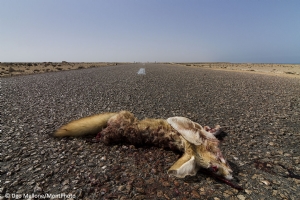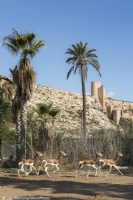Galería Beca bienal MontPhoto 2019
El conflicto entre hombre y naturaleza en el desierto del Sáhara

AUTOR/ES
Ugo Mellone
Ugo Mellone, nacido en Italia en 1983, vive en España desde el 2008. Tras haber obtenido un doctorado en zoología estudiando migraciones de aves rapaces, en la actualidad se dedica a tiempo completo a proyectos fotográficos, sobretodo dedicados a especies amenazadas y lugares remotos. Colabora con ONG onservacionistas, y sus reportajes han sido publicados en revistas como National Geographic (edición ibérica), Terre Sauvage y BBC Wildlife. Ha sido ganador de categoría en el Wildlife Photographer of the Year (2015) y ponente en festivales internacionales de fotografía de naturaleza. Su último libro ("Erg | Reg") está dedicado al Sáhara y a su biodiversidad.
INFORME COMPLETO
Los medios áridos son los grandes olvidados de la conservación. Al considerarse entornos poco atractivos y aparentemente inertes, han atraído poca financiación y esfuerzos de conservación. Numerosas especies de grandes mamíferos saharianos se han extinguido en las últimas décadas, y aquellas que aún perduran, han reducido su área de distribución al menos un 90%. La caza descontrolada es la principal responsable de esta catástrofe.
Como fotógrafo, siempre me han atraído más los espacios abiertos que las selvas. Tras numerosas expediciones al desierto del Sáhara, decidí centrar mi proyecto en una región abrupta del Sáhara Atlántico. La abundancia de cortados, montes isla y barrancos, ha hecho de esta región un refugio para algunas especies de mamíferos carnívoros y ungulados, tal como han desvelado en los últimos años los biólogos españoles de la asociación Harmusch.
En un proyecto como este, las observaciones faunísticas llegan a cuentagotas, y las buenas fotografías con frecuencia aún menor.
Además de tener que hacer esperas larguísimas, concentré mis esfuerzos en la técnica del fototrampeo, diseñando un sistema propio que me permitió alimentar las cámaras durante largos períodos de tiempo con paneles solares. Fruto de esta técnica es la fotografía de las dos gacelas de Cuvier, captada por una cámara que trabajó durante más de 10 semanas, registrando tan sólo cuatro momentos de paso de esta especie.
El desierto del Sáhara todavía alberga parajes intactos que permiten proyectar un futuro esperanzador para su biodiversidad. Ojalá los proyectos de conservación tengan éxito, y montañas pedregosas y campos de arena vuelvan a ser transitados por antílopes y guepardos, como ocurría hasta hace pocas décadas.
Normas de uso del web | Avíso legal | Política de privacidad | Política de cookies | Cambiar preferencias de cookies
Administración | Diseño web: ATMultimedia.com
























